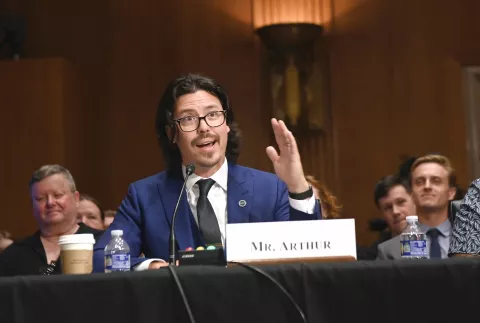John Arthur’s mother used to work at the gift shop at the Capitol. She didn’t want her son to become a public school teacher and was very clear with him about her feelings. The immigrant from Korea came to the U.S. shortly after marrying Arthur’s father, Alan, a West Point graduate who patrolled the DMZ (Demilitarized Zone).

“Like so many immigrant parents, my mom wanted me to grow up to be a doctor or a lawyer,” Arthur told the members of the Committee on Education, Health, Labor, and Pensions (HELP) during a recent hearing on teacher pay. “Finally, in my late twenties, I worked up the courage to tell my Omma that I was going to graduate school to become a teacher. After a long pause, she asked, “Doctor Teacher?” I said, “No, Omma… elementary school teacher.”
Arthur’s mother isn’t the only one who hopes her child chooses another profession. According to data from the Bureau of Labor Statistics, in 2022, there were 567,000 fewer educators in public schools than there were before the pandemic (Jotkoff, 2022). And the figures get even worse when you consider how many educators are planning to leave teaching due to compensation—that’s 48%. (Bryant et al., 2023)
Leaders Who Can Create Change
Arthur, the 2021 Utah State Teacher of the Year was clear about these facts when he advocated for increases in pay to a Senate Committee hearing titled, “The Immediate and Long-Term Challenges Facing Public School Teachers: Low Pay, Teacher Shortages, and Underfunded Public Schools.” To thrive, he said, teachers need four things: increased compensation, supportive communities, greater respect, and room to grow as professionals.
“When we improve teacher pay, strengthen our communities, elevate the professionalism of our incredible educators, and provide greater opportunities for professional growth, then more young Americans will become teachers—not despite their parents’ wishes—to make their parents proud.”
Sharing members’ stories on the national stage creates a place for elected leaders who can create change to truly understand what’s at stake for our nation’s public schools. Many say we have a “teacher shortage,” in this country but if you look more closely and listen to educators like Arthur, a teacher shortage isn’t the problem. The root of the issue is a lack of pay leading to a shortage. This is a critical distinction for the Utah elementary school teacher. “The number one solution to addressing the issues we face must be increasing teachers’ salaries.”
The right leaders save jobs, increase pay, and support our students
During meetings educators are not part of, people elected to office can have the power to make public schools and the profession better or worse. Those are the facts. Thanks to NEA and the advocacy work done to support public education and our students, the Union has been able to fight back against some of the most draconian proposals in recent years.
Here are just some of the good, the bad, and the ugly ideas from elected leaders, at all levels from Congress to local school boards. Now, it’s up to voters to decide which candidates are best for each community, and who will put students first, once in office.

